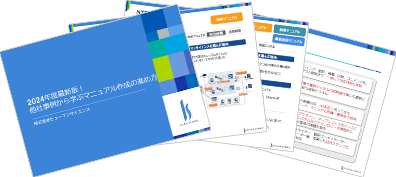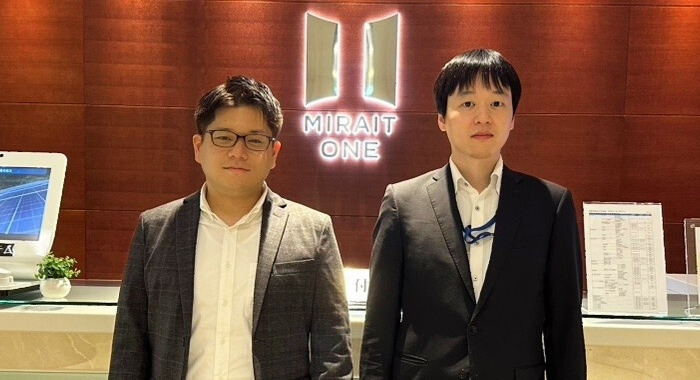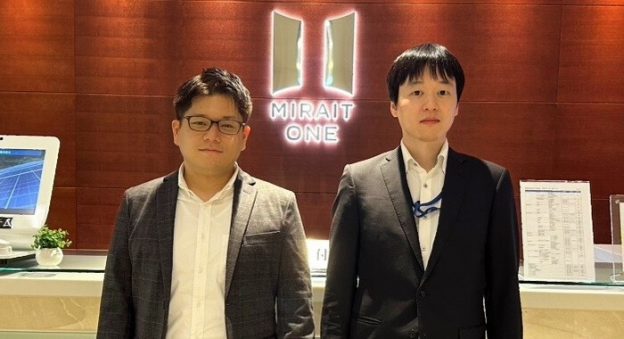

The deciding factor for adoption was the “accompaniment-type support” that learns together and deepens understanding through dialogue while interacting with the new system, even with limited provided materials.
Support was provided not only for manuals but also for organizing operations. By combining videos and PDFs, we realized a system that is “used” on site.

Interview Cooperation:
Mr. Kawashima, System Operations Division, Information Systems Department, Information Strategy Headquarters
Mr. Taneichi (then in charge), System Planning Division, Information Systems Department, Information Strategy Headquarters
Overview of Mirait One Corporation
・Established: October 1, 2010
・Capital: 7 billion yen
・Business Description: Telecommunications construction, electrical work, civil engineering, building construction, and management of subsidiaries and group companies engaged in these related businesses
Services Utilized
・Creation of operation manuals (delivered in Word and PDF)
・Support for organizing business workflows
・Creation of video manuals
Project Background and Challenges
――HS: The first time we received a request from Human Science was in 2022. It was a project to create an operational manual related to the renewal of the in-house system. Could you tell us about the background and details of the project, as well as any challenges you faced at the time of the request?
Mirait One: Yes. First, let me explain the project at that time.
At that time, our company was undertaking a large-scale replacement of the core system to be commonly used, including subsidiaries. We had just entered the system design and testing phase, where the user departments actually operated the system to verify that there were no operational issues.
However, some stages of the project were delayed, and we were unable to prepare system explanation materials and operation manuals in time, creating a situation where we had to urgently organize the documentation.
Since internal resources were limited, we decided to outsource the creation of the operation manuals, which is how we reached out to Human Science.
Reasons for Choosing Human Science Co., Ltd. — The Decisive Factor Was Flexible Responsiveness
――HS: Among the many manual production companies, could you tell us why you chose our company?
Mirait One: We decided after comparing 3 to 4 companies.
The cost being realistic was a major factor. Also, at that time, the total volume of deliverables was unclear, and we couldn’t fully grasp how long the work period would be.
In that situation, Human Science Co., Ltd. responded flexibly from the hearing stage, and we got the impression that they proceeded carefully, including confirming business flows and proposing schedules. That kind of responsiveness was the deciding factor.
Implementation Effects and Evaluation of Human Science Co., Ltd.
――HS: What was your impression of the progress and scheduling during the actual delivery?
Mirait One: We proceeded from a state of having no knowledge about system operations by deepening our understanding together while reviewing the system at the specification confirmation stage. It was helpful that, while checking the operation details by looking at the actual screens, the business processes were organized through hearings with the stakeholders. Despite the limited information we could provide, they created a manual that was not just about following the system specifications but was mindful of the users’ business workflows. Thanks to this professional know-how, I feel the manual was made more practical than if we had produced it in-house.
――HS: What kind of results or feedback did you see within your company through this manual production?
Mirait One: The videos received relatively positive feedback, and I got the impression that many people were willing to "just give it a try". Long PDF manuals were cumbersome to read, and many tended to rely on inquiries, but with the video format, more people seemed willing to "just give it a try".
Also, the manuals we used to create ourselves were minimal in content and had inconsistent formats, but this time they were properly organized and became easier to understand.
――HS: What aspects made you feel that users responded better to the videos?
Mirait One: It’s definitely the fact that you can watch the entire flow of screen operations in one go.
With PDFs, you have to keep going back and forth between screenshots and explanatory text, but the advantage of videos is that you can see the whole sequence of operations on an actual working screen.
Regarding operation manuals, videos are better suited than PDFs in some respects. Especially for dynamic elements like "what happens when you press which button," paper has its limits. Videos are definitely much easier to understand.
――HS: Certainly, videos have their own advantages, but the comprehensiveness of PDF manuals is also important. Could you tell us how you differentiated the use of both in this project?
Mirait One: Yes. For example, we used videos to check how the system operates, and PDFs to verify detailed functional specifications and rules. By using both rather than just one, I believe our understanding deepened.
――HS: Looking back now, could you give us your evaluation in one word?
Mirait One: I appreciate that you not only created the manual but also organized the workflow and background together. The system has undergone further modifications since then, and our internal staff use the original manual data (Word files and illustration data) to update the necessary parts. Thanks to having a base manual, we have established a foundation to build a "self-sustaining system."
Future Prospects
――HS: Is there a possibility that you will need similar support in the future?
Mirait One: Yes. If there are significant system feature additions or business reorganizations in the future, we will need to revise the business flows and manuals again. At that time, we would like to ask for your assistance once more.
――HS: Are you also interested in new ways to utilize documents, such as integration with generative AI and FAQs?
Mirait One: Actually, we have recently started trialing AI chatbot-based inquiry support within the company. We are very interested in initiatives that make internal information easier to use, so we would definitely like to consult with you if anything comes up.
From Human Science Representatives
In this project, there were a great number of stakeholders, and you faced the highly challenging task of standardizing business workflows. We are very pleased that we could work together not just as a "manual creation company," but as a partner in business organization.
We are deeply grateful to Mr. Taneichi and Mr. Kawashima for acting as intermediaries between the representatives of each business division and the system development team and our company, coordinating and scheduling to ensure smooth communication.
Moving forward, we will continue to propose "information utilization support" that goes beyond manuals, such as video manuals, AI-powered FAQs, and inquiry handling using RAG technology.
Thorough introduction of case studies on manual creation from other companies!Learn from case studies of other companies
How to proceed with manual creation
Before starting to create a manual, by learning about other companies' manual creation examples, you can understand the "key points of creation" and "common challenges" to gain hints for manual creation.
Recommended for
- I want to proceed with manual creation, but there is too much volume, and I don't know where to start.
- ・I am unsure if I can accomplish what I want to do in-house
- ・I want to know how other companies are progressing with manual creation

[Introducing Companies]
- TOTSUMEDIA Inc.
- BANDAI SPIRITS CO., LTD.
- NTT DATA KANSAI CORPORATION
- SBI SECURITIES Co.,Ltd.
- NNTTDATA CUSTOMER SERVICE CORPORATION
- WingArc1st Inc.
- Nippon Sheet Glass Co., Ltd.



